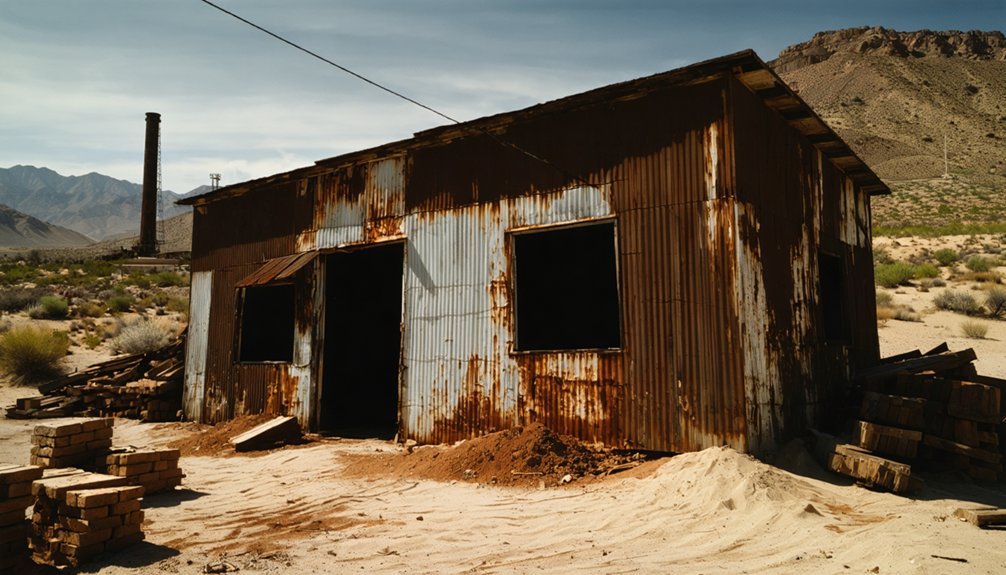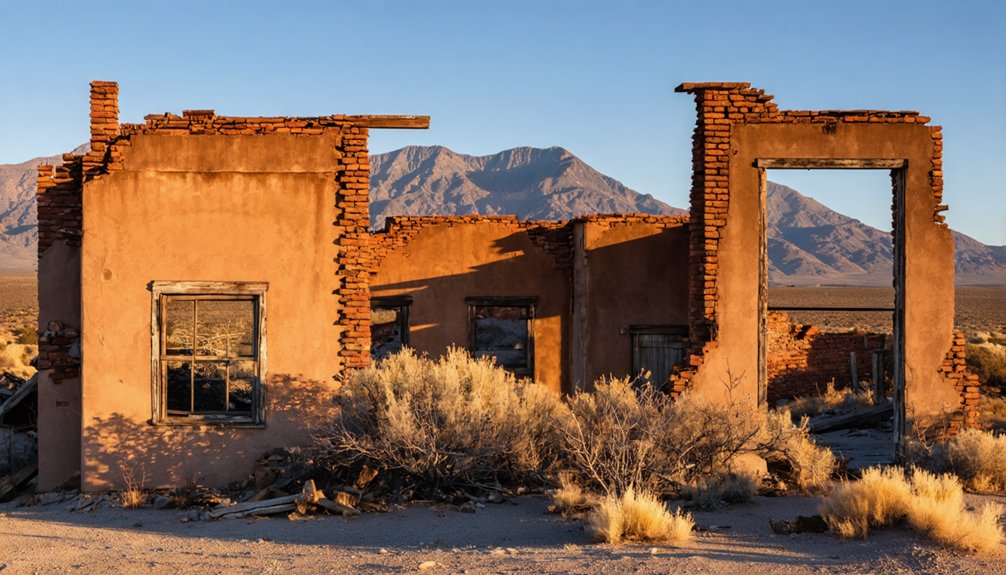You’ll find Smeltertown’s haunting remains near El Paso, Texas, where a once-thriving Mexican-American mining community lived and worked from 1887 until the 1970s. The ASARCO smelter’s 828-foot smokestack dominated the landscape while processing copper, lead, and zinc. Widespread lead poisoning forced the evacuation of nearly 900 residents, leaving only a cemetery, church, and school behind. Today, former residents gather annually to honor their resilient community’s legacy.
Key Takeaways
- Smeltertown became a ghost town after ASARCO smelter’s lead contamination forced resident evacuation and demolition of homes in the 1970s.
- The abandoned site contains only remnants of San Jose Church, Jones School, and La Esmelda cemetery as evidence of former community life.
- Founded in 1887 near El Paso, Smeltertown was a thriving Mexican-American community until environmental health concerns led to its abandonment.
- The 828-foot ASARCO smokestack dominated the ghost town’s landscape until the smelter’s final closure in 1999.
- Former residents maintain Smeltertown’s memory through annual reunions, cultural celebrations, and preservation of the historic cemetery.
The Birth and Growth of a Mining Community
When the Kansas City Consolidated Smelting and Refining Company constructed its smelter near the Rio Grande in 1887, it laid the foundation for what would become Smeltertown, Texas. The strategic location, with its access to railroads and highways, made it ideal for processing copper and lead ores using advanced mining technology of the time. Similar to the community of fifty worker homes that were built in Smeltertown, Colorado in 1901, this Texas town featured worker housing near the industrial site. You’ll find the town’s roots in the modest adobe homes built west of the smelter, primarily housing Mexican workers who showed remarkable community resilience despite challenging conditions. The smelter would later become part of ASARCO in 1899, growing into one of the region’s most significant industrial operations.
Life in the Shadow of the Smelter Stack
As ASARCO’s towering 828-foot smokestack dominated the Smeltertown skyline in 1967, residents faced an increasingly toxic environment despite the company’s attempts to reduce ground-level sulfur dioxide emissions.
You’d find a community marked by industrial nostalgia, where 900 workers, many Mexican migrants, braved hazardous conditions processing copper, lead, and zinc with minimal protection.
The price of this industrial livelihood proved devastating. By 1969, El Paso recorded Texas’s highest air lead levels, with 72 of 500 Smeltertown residents suffering lead poisoning.
Lead poisoning ravaged Smeltertown, afflicting over seventy residents and marking El Paso as Texas’s most contaminated industrial zone.
Despite the community’s resilience through labor struggles and harsh living conditions, the environmental crisis forced authorities to relocate families in the early 1970s. The Kansas City Consolidated Company established the smelting operation before becoming ASARCO.
You can still sense the weight of this displacement, which erased a crucial Mexican-American neighborhood and left only abandoned structures as silent witnesses. The community originally took shape when ASARCO acquired 1,156 Rio Grande acres in the late 1880s.
Cultural Heritage and Social Dynamics
Though geographically isolated, Smeltertown fostered a vibrant Mexican-American cultural identity through its tightly-knit social fabric and cross-border dynamics.
You’d find the San Jose Church (Santa Rosalia) at the heart of community life, while the Jones School educated local youth. Cultural artifacts discovered during archaeological projects reveal the blend of Mexican and American influences that shaped daily life. Old structures remain as testament to the community’s rich industrial heritage.
The community’s identity wasn’t just tied to the ASARCO smelter – it thrived through independent social networks, shared customs, and cross-border relationships. Archaeological digs have uncovered Spanish-language bottles and other artifacts that demonstrate the strong cultural connections to Mexico.
You can still see traces of this heritage in La Esmelda cemetery, where weathered grave markers tell stories of generations past.
Despite the town’s physical erasure, former residents’ oral histories preserve the rich cultural tapestry of this unique borderland community where Mexican traditions merged with American industrial life.
Environmental Legacy and Health Crisis
You’ll find that Smeltertown’s most devastating environmental legacy stems from the ASARCO smelter’s toxic emissions, which caused blood lead levels in local children to spike as high as 80-90 mg/dL, far exceeding today’s CDC safety guidelines.
The health crisis prompted officials to relocate residents and raze the entire community, leaving behind a contaminated landscape that required extensive EPA oversight. The site’s contamination history dates back to 1902 ore processing and subsequent slag disposal activities. CDC team findings in the mid-1970s faced resistance from local pediatricians who were funded by the lead industry.
The cleanup challenges continue to shape El Paso’s environmental policies, as the former smelter site undergoes ongoing remediation efforts to contain and neutralize decades of accumulated heavy metals and pollutants.
Lead Poisoning Health Impact
While operating in El Paso, the ASARCO smelter created a devastating health crisis in Smeltertown, where approximately 70% of children showed blood lead levels exceeding 40 μg/dL during the late 1960s and early 1970s.
As you’d discover from health investigations at the time, lead exposure permeated every aspect of residents’ lives through contaminated air, water, soil, and dust. The impact was particularly severe on children, leading to cognitive deficits and behavioral problems that would affect their futures. Studies later revealed children with elevated lead exposure had IQ scores 7 points lower than their peers. The New York Times expose brought national attention to the severe health impacts affecting the community.
- At least 35 Smeltertown children required hospitalization for lead poisoning
- Lead contamination decreased with distance – 35% of children in Zone One had elevated levels
- The smelter released 1,012 metric tons of lead between 1969-1971
- Infants were especially vulnerable, with some reportedly lost to lead poisoning
- Studies revealed subclinical neurological effects even without obvious symptoms
Environmental Cleanup Challenges
After decades of smelting operations ceased, Smeltertown faced massive environmental cleanup challenges due to widespread heavy metal contamination.
You’ll find the legacy of lead, arsenic, copper, and cadmium persists in the soil from years of ore processing. While the EPA implemented remediation strategies from 1993-2003 by removing contaminated topsoil and installing protective caps, concerns remain about ongoing risks.
Community involvement has highlighted worries about mining operations potentially re-mobilizing metal-rich dust into the air. Despite EPA’s containment efforts, the site requires continuous monitoring to guarantee containment measures remain effective.
The challenge extends beyond direct emissions – wind-blown particulates contaminated surrounding residential areas, and improper waste disposal practices, including burning hazardous materials, complicated cleanup efforts.
These environmental impacts continue to shape discussions about the site’s future management.
The Forced Exodus and Abandonment

You’ll find that Smeltertown’s forced exodus began in the early 1970s when environmental studies revealed dangerous levels of lead contamination affecting residents, particularly children.
The city and federal authorities mandated evacuation despite community resistance, compelling families to relocate primarily to El Paso housing projects.
As homes were demolished and institutions like the E.B. Jones School closed, only the church, school building, and cemetery remained as physical evidence of the once-vibrant industrial community.
Public Health Crisis Unfolds
Despite decades of resident complaints about pollution, the devastating public health crisis in Smeltertown came to a head in the 1970s when medical studies revealed widespread lead poisoning throughout the community.
The toxic exposure from ASARCO’s copper and lead smelter had silently ravaged residents’ health since 1887, with children bearing the worst effects.
Despite their community resilience, you’d find 72 hospitalized cases, including 35 children, as medical evidence mounted.
- Lead contamination in blood became the primary basis for condemnation
- 72 residents required hospitalization for severe lead poisoning
- Children suffered disproportionate health impacts from the exposure
- Respiratory illnesses compounded the lead poisoning effects
- Local authorities ignored health complaints until federal intervention
Community’s Final Departure
When environmental studies revealed dangerous lead contamination in 1975, Smeltertown’s residents faced a devastating forced exodus from their generational homes.
Despite strong resident resistance and deep community ties, you’ll find the City of El Paso enforced a court-mandated evacuation to protect public health after decades of toxic exposure.
The displacement scattered families into public housing projects across El Paso, permanently disrupting established social networks.
You can trace how officials demolished homes, leaving only the church, school, and cemetery as physical remnants of this once-vibrant Mexican-American barrio.
While ASARCO offered compensation settlements, many residents viewed these with skepticism, given years of neglected health complaints.
The forced departure marked the end of El Paso’s first major industrial community, though former residents maintain strong collective memories of their lost neighborhood.
What Remains: Preserving Smeltertown’s Memory
Although Smeltertown’s industrial operations ceased in 1999, significant efforts have preserved essential elements of this historic community’s legacy.
Through dedicated community engagement, volunteers have restored the historic Smeltertown Cemetery, earning statewide historical recognition with a new marker.
While most physical structures are gone, you’ll find the community’s spirit alive through oral histories, cultural celebrations, and annual reunions.
- La Calavera Historic Neighborhood stands as the last remaining residential area
- Smeltertown Cemetery contains graves dating to the 1800s with personal trinkets
- Oral histories document life “in the bowels of Hell” and community resilience
- Annual reunions feature dances, golf tournaments, and cultural celebrations
- Literature, poetry, and Day of the Dead tributes keep memories alive
Frequently Asked Questions
What Happened to the Machinery and Equipment After the Smelter Closed?
You’ll find the machinery disposal and equipment salvage involved selling valuable assets, recycling usable metals, and handling hazardous materials through specialized waste facilities under a $52 million custodial trust’s oversight.
Did Any Former Residents Successfully Sue ASARCO for Health Damages?
While health lawsuits were filed, you won’t find records of successful individual damage awards from ASARCO for Smeltertown residents, though asbestos exposure claims were later handled through a separate bankruptcy trust fund.
Were There Any Documented Paranormal Activities in Abandoned Smeltertown Buildings?
You’ll find anecdotal reports of ghost sightings and paranormal investigations in Smeltertown’s ruins, but there’s no verified scientific evidence. Local groups have documented unexplained voices, footsteps, and shadowy figures.
What Alternative Locations Were Offered to Displaced Smeltertown Residents?
You’d find relocation options included nearby El Paso neighborhoods with existing utilities and schools, plus new housing developments. Community support programs helped you secure safer homes away from contaminated areas.
How Did Property Values in Surrounding Areas Change After Smeltertown’s Closure?
You’d find conflicting property trends in surrounding areas, with nearby neighborhoods seeing initial value drops due to contamination fears, though no extensive economic impact data exists from that period.
References
- https://epcc.libguides.com/c.php?g=754275&p=5406094
- https://solsticelitmag.org/blog/a-writer-photographers-poignant-essay-about-smelter-town/
- https://en.wikipedia.org/wiki/Smeltertown
- https://borderzine.com/2012/11/smelter-town-–-a-personal-look-at-a-ghost-town-firmly-embedded-in-el-paso-history/
- https://www.ghosttowns.com/states/tx/smeltertown.html
- https://www.tshaonline.org/handbook/entries/asarco
- https://www.youtube.com/watch?v=efEA1hpctd4
- https://www.digie.org/media/14947
- https://epcc.libguides.com/c.php?g=754275&p=5406093
- https://arkvalleyvoice.com/history-lives-turret-whitehorn-and-smeltertown/



